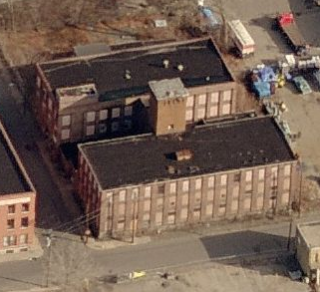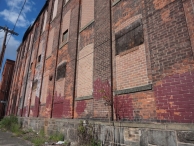Mill Record Waterbury
RETURN TO ‘FIND MILLS’Disclaimer: Content for these properties was compiled in 2014-2017 from a variety of sources and is subject to change. Updates are occasionally made under Property Information, however the Connecticut Trust for Historic Preservation (dba Preservation Connecticut) makes no representation or warranty that the information is complete or up-to-date.
- Complex Name (Common)
- M. Heminway and Sons Silk Co.
- Complex Name (Historic)
-
- M. Heminway and Sons Silk Co.
- Address or Location
- 59 West Clay Street, Waterbury
- County
- New Haven
- Historic Designation
- Associated Mill Community
- n/a

- Historic Information
Companies Associated w/Complex
- Caprin Mfg. Works c.1917
- M. Heminway and Sons Silk Co. c.1901
- Tracey Bros. Co. c.1917-1922
- Waterbury Mattress Co. c.1940-c.1950
- Worcester Metal Goods Co. c.1922
Use (Historic)
Largest Documented Workforce
600 for all locations (1913)
Historic Narrative
The factory appears to have been built by M. Heminway and Sons Silk Co. The company was established in Watertown c.1846 by General Merit Heminway (1800-1886), who is credited as the first businessman to make sewing silk on spools. With the success of spooled silks, Heminway expanded initially with the Waterbury factory c.1895-1900, followed by another factory in Watertown in 1913. With the third facility, Heminway was projected to employ a total of 600 employees, approximately 200 of which worked in Waterbury. Heminway was purchased in 1917 by Hammon Knowlton and Co. of Putnam, Connecticut, and subsequently known as HKH Co. It appears that the Waterbury factory was sold with the change in ownership. New occupants in 1917 included the Caprin Mfg. Works and Tracey Brothers Co., a building contractor. Tracey Brothers bid on a variety of projects, including an addition to the Excelsior Needle Co., on Field Street in Torrington in 1914 which it did not win, three additions to the Waterbury Rolling Mills awarded in 1917, and the Waterbury Rolling Mills administration building awarded in 1919. In 1918, the firm held a $965,000 contract to build worker housing in Waterbury (project nbr. 380) for the United States Housing Corp. It was also the general contractor for construction of the Basilica of the Immaculate Conception Roman Catholic Church at 74 West Main Street, Waterbury, dedicated in 1928. By 1922, a hardware manufacturer, Worcester Metal Goods Co., occupied the site; the company held a patent for a levered fastener.
- Architectural Information
Number of Existing Buildings
Two (2) primary blocks.
Dates of Construction
c.1900, c.1923-1949
Architect
n/a
Builder
n/a
Building Type
Architectural Description
The complex is comprised of two primary blocks. The three-story brick pier factory along Benedict Street was built between 1895 and 1900. Approximately 50 ft wide by 124 ft long, it has segmental arched window openings with stone sills, granite foundation and corbelled window bay headers. A four-story brick stair tower, with decorative arched corbelling, is centrally located on the east side of the building. The original boiler house may remain at the southeast corner of this block, however it is obscured with more modern infill additions. A second three-story brick pier block, approximately 50 ft wide by 114 ft long, was built to the east off West Clay Street parallel to the first block between 1923 and 1949. It has rectangular window openings with brick sills and headers, and corbelled window bay headers and corbelled roof cornice along West Clay Street. A brick rooftop enclosure sits at the northwest corner.
Exterior Material(s)
Structural System(s)
Roof Form
Roof Material
Power Source
n/a
Condition
Fair
Condition Notes
The windows are largely bricked in or boarded up.
- Property Information
- Sources
-
Form Completed By
Renée Tribert
Date
October 2016
Bibliography
- Sanborn Insurance Atlases.
- The Connecticut Magazine, Vol. 11 (Hartford: The Connecticut Magazine Co., 1907).
- Twenty Third Report of the Bureau of Labor Statistics for the Two Years Ended November 30 1908 (Hartford: State of Connecticut, 1908).
- The American Silk Journal, Vol. 31 (New York: American Silk Journal, 1912).
- Engineering News: A Journal of Civil Engineering and Construction, Vol. 72 (New York: Hill Publishing Co., 1914).
- Iron Trade Review, Vol. 60 (Cleveland: the Penton Publishing Co., 1917).
- Operations of the United States Housing Corporation: Hearings before a subcommittee of the committee on public buildings and grounds United States senate (Washington: Government Printing Office, 1918).
- Pape, William J., History of Waterbury and the Naugatuck Valley, Vol. 1 (New York: S. J. Clarke Publishing Co., 1918).
- Biennial Reports of the Factory Inspection Department (Hartford: State of Connecticut, 1918, 1920).
- The American Contractor, Vol. 40 (New York: The American Contractor Publishing Co., 1919).
- 'Basilica of the Immaculate Conception (Waterbury, Connecticut),' Wikipedia. Web; accessed October 2016.
- Patent information.
- Representative View(s)Click on image to view full file





